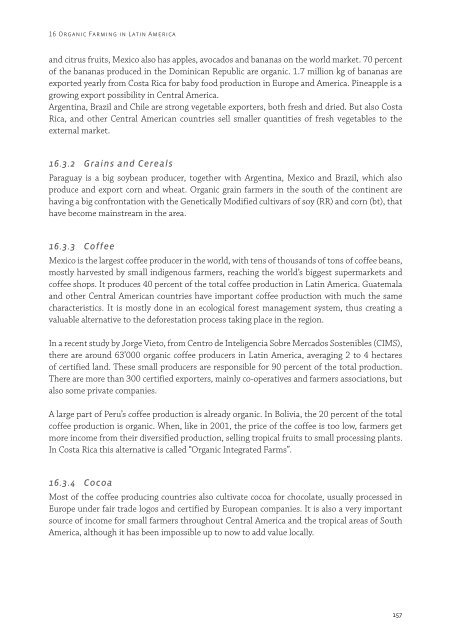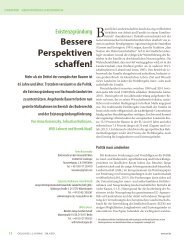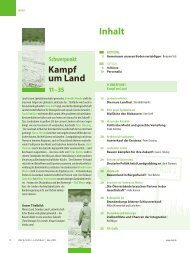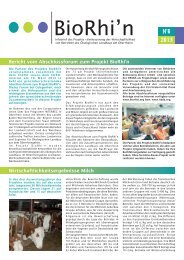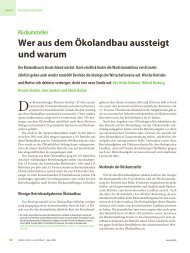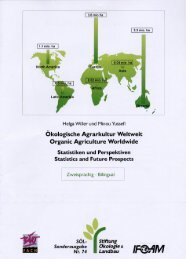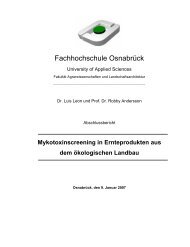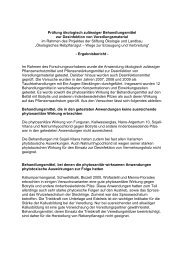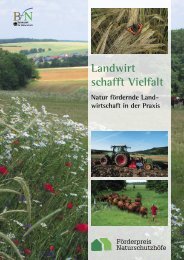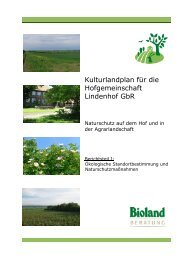the world of organic agriculture - Organic Eprints
the world of organic agriculture - Organic Eprints
the world of organic agriculture - Organic Eprints
You also want an ePaper? Increase the reach of your titles
YUMPU automatically turns print PDFs into web optimized ePapers that Google loves.
16 <strong>Organic</strong> Farming in Latin America<br />
and citrus fruits, Mexico also has apples, avocados and bananas on <strong>the</strong> <strong>world</strong> market. 70 percent<br />
<strong>of</strong> <strong>the</strong> bananas produced in <strong>the</strong> Dominican Republic are <strong>organic</strong>. 1.7 million kg <strong>of</strong> bananas are<br />
exported yearly from Costa Rica for baby food production in Europe and America. Pineapple is a<br />
growing export possibility in Central America.<br />
Argentina, Brazil and Chile are strong vegetable exporters, both fresh and dried. But also Costa<br />
Rica, and o<strong>the</strong>r Central American countries sell smaller quantities <strong>of</strong> fresh vegetables to <strong>the</strong><br />
external market.<br />
16.3.2 Grains and Cereals<br />
Paraguay is a big soybean producer, toge<strong>the</strong>r with Argentina, Mexico and Brazil, which also<br />
produce and export corn and wheat. <strong>Organic</strong> grain farmers in <strong>the</strong> south <strong>of</strong> <strong>the</strong> continent are<br />
having a big confrontation with <strong>the</strong> Genetically Modified cultivars <strong>of</strong> soy (RR) and corn (bt), that<br />
have become mainstream in <strong>the</strong> area.<br />
16.3.3 C<strong>of</strong>fee<br />
Mexico is <strong>the</strong> largest c<strong>of</strong>fee producer in <strong>the</strong> <strong>world</strong>, with tens <strong>of</strong> thousands <strong>of</strong> tons <strong>of</strong> c<strong>of</strong>fee beans,<br />
mostly harvested by small indigenous farmers, reaching <strong>the</strong> <strong>world</strong>’s biggest supermarkets and<br />
c<strong>of</strong>fee shops. It produces 40 percent <strong>of</strong> <strong>the</strong> total c<strong>of</strong>fee production in Latin America. Guatemala<br />
and o<strong>the</strong>r Central American countries have important c<strong>of</strong>fee production with much <strong>the</strong> same<br />
characteristics. It is mostly done in an ecological forest management system, thus creating a<br />
valuable alternative to <strong>the</strong> deforestation process taking place in <strong>the</strong> region.<br />
In a recent study by Jorge Vieto, from Centro de Inteligencia Sobre Mercados Sostenibles (CIMS),<br />
<strong>the</strong>re are around 63’000 <strong>organic</strong> c<strong>of</strong>fee producers in Latin America, averaging 2 to 4 hectares<br />
<strong>of</strong> certified land. These small producers are responsible for 90 percent <strong>of</strong> <strong>the</strong> total production.<br />
There are more than 300 certified exporters, mainly co-operatives and farmers associations, but<br />
also some private companies.<br />
A large part <strong>of</strong> Peru’s c<strong>of</strong>fee production is already <strong>organic</strong>. In Bolivia, <strong>the</strong> 20 percent <strong>of</strong> <strong>the</strong> total<br />
c<strong>of</strong>fee production is <strong>organic</strong>. When, like in 2001, <strong>the</strong> price <strong>of</strong> <strong>the</strong> c<strong>of</strong>fee is too low, farmers get<br />
more income from <strong>the</strong>ir diversified production, selling tropical fruits to small processing plants.<br />
In Costa Rica this alternative is called “<strong>Organic</strong> Integrated Farms”.<br />
16.3.4 Cocoa<br />
Most <strong>of</strong> <strong>the</strong> c<strong>of</strong>fee producing countries also cultivate cocoa for chocolate, usually processed in<br />
Europe under fair trade logos and certified by European companies. It is also a very important<br />
source <strong>of</strong> income for small farmers throughout Central America and <strong>the</strong> tropical areas <strong>of</strong> South<br />
America, although it has been impossible up to now to add value locally.<br />
157


